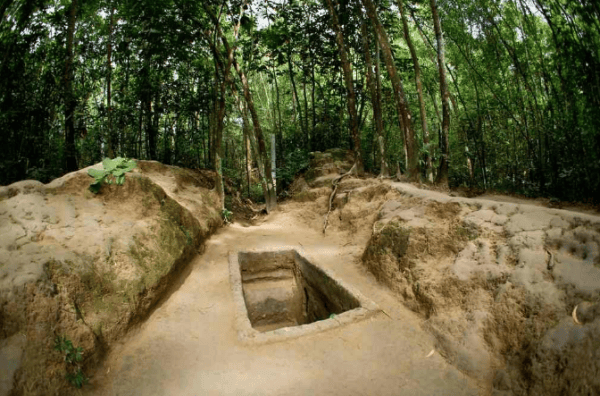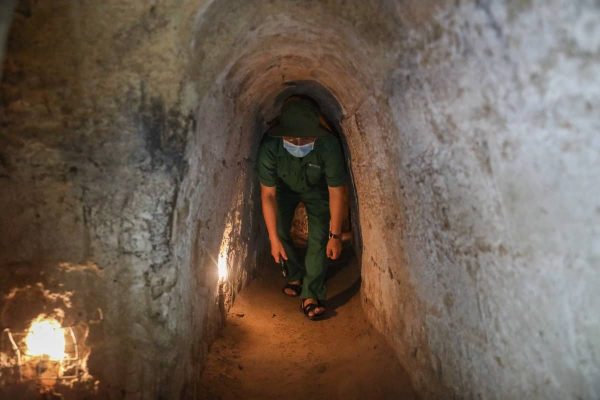
The Cu Chi Tunnels
Discover the fascinating history of Cu Chi Tunnels, a unique underground network used during the Vietnam War. Learn tips for visiting, what to expect, and why it’s a top attraction for international travelers. Follow Ula Travel today!
I. Overview of the Cu Chi Tunnels
The Cu Chi Tunnels, located on Provincial Road 15, Phu Hiep Hamlet, Phu My Hung Commune, Cu Chi District, Ho Chi Minh City, are closely associated with the resistance against French colonial rule from 1946 to 1948. These tunnels were constructed by the military and residents of Tan Phu Trung Commune and Phuoc Vinh An Commune to facilitate hiding, storing weapons, and other activities.

Structure of Cu Chi tunnels
The tunnel system spans a total length of up to 250 kilometers, consisting of three different depth levels, with the deepest level reaching 12 meters below ground. Initially, each village had its own underground base, but later, the residents interconnected them to facilitate communication during the period from 1961 to 1965.
Externally, the tunnels were equipped with numerous booby traps, bell pits, and minefields to ensure safety. Internally, the military tunnels allowed for easy communication, the hiding of forces and weapons, and the planning revolutionary activities. To date, six northern districts have been linked through the tunnel network.
The Cu Chi Tunnels are a special national historical relic and one of the six famous man-made structures in the world today. Combined with tourism, visiting the tunnels has become a major attraction for domestic and international tourists, ranking among the top 7 most peculiar destinations in Southeast Asia.
II. The History and Significant Role of the Cu Chi Tunnels
1. Role in the Vietnam War
During the Vietnam War, the Cu Chi Tunnels played a crucial role in the “people’s war” strategy of the Vietnamese army. Despite lacking modern weapons and equipment, the Vietnamese forces maximized the advantages of the terrain and tunnel system to counter the powerful U.S. and allied forces.

The Cu Chi tunnels are places to hide and hide weapons during war
The tunnel system was not only a hiding place but also a secret communication and transportation network. The tunnels were designed with numerous passages, trapdoors, and escape routes, making it difficult for the enemy to detect and destroy them. The Vietnamese army used the tunnels to organize guerrilla attacks, destroy enemy bases, and inflict significant losses on the opposition.
Additionally, the tunnels served as living and fighting spaces for thousands of soldiers and civilians. Inside the tunnels, field hospitals were set up to treat the wounded, food and weapon supplies were carefully stored, and command rooms were arranged to manage operations.
2. Real Stories from Veterans
Stories from veterans who lived and fought in the Cu Chi Tunnels offer a genuine and emotional perspective on the harsh life underground. Many veterans recall that living in the tunnels was a tremendous physical and mental challenge. The cramped, dark, and suffocating conditions made life extremely difficult. However, their unity and fighting spirit helped them overcome all hardships.
One veteran shared, “We had to live in darkness for months, only able to go out at night to find food and water. But it was our solidarity and patriotism that helped us endure every difficulty.”
Such stories not only deepen historical understanding but also attract international tourists eager to learn about the heroic struggle of the Vietnamese people.
3. Harsh Experiences Inside the Tunnels

Visitors experience small and narrow underground passageways.
For tourists visiting the Cu Chi Tunnels today, experiencing a small part of life inside the tunnels is a must-do activity. Visitors can explore some sections of the tunnels that have been widened and renovated for tourism. However, even these sections reveal the cramped and challenging conditions that soldiers had to endure.
Many tourists share that after just a few minutes of crawling through the tunnels, they felt exhausted and suffocated. This helps them better appreciate the resilience and perseverance of the soldiers who lived and fought under such harsh conditions for years.
4. How the Vietnamese Army Lived and Fought Underground
The underground life of the Vietnamese army in the Cu Chi Tunnels is a testament to their creativity and adaptability. To survive in such a harsh environment, soldiers developed various survival skills, from digging wells for fresh water to growing vegetables and raising livestock inside the tunnels.
Field hospitals were equipped with simple yet effective medical tools, saving many wounded soldiers. Food and weapon supplies were strategically arranged to ensure continuous support for operations.
The Vietnamese army also used the tunnels to conduct surprise attacks, causing confusion among the enemy. Guerrilla tactics, combined with the tunnel system, helped the Vietnamese army achieve significant victories, contributing to the nation’s ultimate triumph.
Click here: Ho Chi Minh City Tour
III. How to Get to Cu Chi Tunnels
The Cu Chi Tunnels are approximately 70 kilometers away from the center of Ho Chi Minh City, so you have various transportation options depending on your preference.
- Personal vehicle: A motorcycle or self-driving car is a convenient and cost-effective option. From the center of Ho Chi Minh City, you would head towards the An Suong intersection, follow National Highway 22, and reach the Cu Chi district. The route is straightforward, and you can follow the directions on Google Maps.
- Taxi: If you’re coming from a distance and don’t have a personal vehicle but still want to explore the Cu Chi Tunnels, you can opt for a taxi. The cost will vary, but typically ranges from 500,000 to 600,000 VND per trip.
- Bus: To get to the tunnels, you would take two busses, departing from Ben Thanh bus station, traveling by bus route 13 to Cu Chi bus station, and then changing to bus route 79. By bus, the entire trip takes roughly two to three hours.
IV. Best Things to Do in Cu Chi Tunnels
1. Exploring the Cu Chi Tunnels

Inside the Cu Chi tunnels
The Cu Chi tunnels system is an incredible feat of engineering by Vietnamese soldiers and locals during the war. With a height of only about 80 cm and a width of less than 1 meter, the tunnels require visitors to crouch or crawl. This is your chance to experience the hardships and determination of Vietnamese soldiers.
Inside the tunnels, you’ll discover small rooms used as meeting spaces, medical stations, kitchens, and even weapon workshops. The 250 km-long tunnel system served as a living and fighting space for soldiers and locals, helping them evade enemy attacks.
Read more: Best things to do in Ho Chi Minh City
2. Exploring the War Recreation Area

The War Recreation Area
The War Recreation Area is constructed within a small underground bunker near the surface. Inside, there’s a large projection screen and simple chairs. Here, visitors can watch valuable war footage documenting the daily lives and combat of our soldiers and civilians. Some scenes are from actual documentary footage, while others are reenactments.
Additionally, at the Cu Chi Tunnels, you’ll have the opportunity to admire numerous historical artifacts, such as the types of guns used by our army during the resistance against the French, tanks, fighter planes, etc. These artifacts are meticulously preserved, and while you can admire them, touching them is not allowed to avoid damage.
3. The Liberated Zone Recreation Area of Cu Chi
As the name suggests, this is where you can watch documentary footage of the intense historical years of the soldiers and people of Cu Chi from 1961 to 1972. This area is divided into three main spaces:

Recreate the learning space of Cu Chi officials
Space 1: Reenacts the life of fighting, working, studying, and living of the people, officials, and guerrilla fighters of Cu Chi through vivid models.

Recreates the countryside in Cu Chi during the war
Space 2: Recreates the devastation of the countryside with fragments of bombs and shells remaining on Cu Chi land, as well as the painful lives of the people during the peak of the fierce war.

Recreates the desolation of Cu Chi in wartime
Space 3: Recreates the desolate land of Cu Chi under the destruction of bombs and shells, where only tank carcasses, airplanes, and people living underground remain.
4. Shooting Experience at the Firing Range

Experience the shooting range at the Cu Chi Tunnels.
For adventure enthusiasts, the shooting experience at the Cu Chi firing range is a must-try activity. You’ll have the chance to handle famous weapons like the AK-47 and M16 – guns used during the war.
Before participating, you’ll receive detailed instructions on how to use the weapons and safety rules. Staff are always on hand to ensure everything runs smoothly. This is a rare opportunity to experience the feeling of holding real guns and learn more about wartime history.
There are two options available:
- National Defense Sports Shooting: This military-inspired sport is popular among many visitors. You can experience shooting with various weapons in wartime after being fully instructed on how to use them and the shooting techniques. You can then test your marksmanship skills on animal-shaped targets at the shooting range.
- Paintball Shooting: This is a team-based military and sports activity. With this game, you’ll become soldiers fighting in the jungle. Each person will be equipped with full protective gear, including masks, uniforms, armor, and weapons like AR15 or AK47 rifles. Paintball shooting will help you demonstrate teamwork, judgment, and quick reflexes. This is an entertainment activity that visitors should not miss at the Cu Chi Tunnels due to its attractiveness and absolute safety.
The ticket price for experiencing these activities at the Cu Chi Tunnels is 50,000 VND per person for 60 minutes.
5. Entertainment and Water Games Area

Water games area in the Cu Chi Tunnels
The game area is also located within the Liberated Zone Recreation Area of Cu Chi. After walking for about 15 minutes, you’ll encounter a scenic lake resembling the East Sea, alongside precious wood forests and three iconic architectural models representing the three regions: One Pillar Pagoda, Ngoc Mon Gate, and Ho Chi Minh Museum at Dragon Wharf.
At the Cu Chi Tunnels, you can also enjoy many exciting games such as cycling, swimming, and kayaking. You’ll need to purchase tickets to play these games according to the posted price list.
6. Exploring Bamboo Traps and Defense Tactics

Bamboo trap at Cu Chi tunnels.
A highlight of the Cu Chi Tunnels tour is learning about the ingenious traps and defense tactics used by Vietnamese soldiers. Made from bamboo and wood, these traps were simple yet highly effective, playing a crucial role in the victory of Vietnamese forces.
Guides will explain how each trap works, such as spike traps, pit traps, and flip traps. These designs showcase not only creativity but also the determination to protect the homeland.
7. Visit the Wildlife Rescue Station

The wildlife rescue station at the Cu Chi Tunnels
The Wildlife Rescue Station is not part of the Cu Chi Tunnels, but it’s only a few kilometers away. Therefore, it’s a very appealing destination for school groups from grades 1 to 2. This rescue station is the largest wildlife hospital in the southern region. Currently, it’s rescuing about 3,600 species of rare animals, many of which are listed in the Red Book.
The rescue station is designed on a large scale, creating conditions for wildlife to live in the environment closest to nature. Witnessing these rare animals up close is sure to be a memorable experience in your travel journey, exploring the Cu Chi Tunnels.
Learn more about: Cu Chi Tunnels Half Day Tour
V. Cu Chi Tunnels Entrance Ticket Prices
Opening hours: 7:00 a.m.–5:00 p.m. daily, including Sundays and holidays.
Reference ticket prices for Cu Chi Tunnels 2025:
Entrance ticket:
- Adults: 35,000 VND/person (for Vietnamese guests), 70,000 VND/person (for foreign guests).
- Children from 7 to 16 years old and students: 50% discount compared to adult ticket prices
People with disabilities, children under 7 years old, armed forces officers and soldiers, elderly people, revolutionary contributors, and poor households: free entrance tickets.
- Tickets for visiting the Cu Chi Liberation Reenactment Area: 40,000 VND/person
In addition, if you want to crawl into the tunnels or participate in some games here, you will have to purchase tickets according to the regulations of the Cu Chi Tunnels Management Board.
VI. Tips for Visiting Cu Chi Tunnels
1. Best Time to Visit Cu Chi Tunnels
The dry season in Southern Vietnam lasts from November to April, and this is the golden time to visit Cu Chi Tunnels. Reasons to choose the dry season:
- Favorable weather: Little rain, mild sunshine, and pleasant temperatures, suitable for outdoor activities.
- Dry paths: The tunnel system and surrounding areas are not damp, making movement and exploration easier.
- Avoid flooding: The rainy season (from May to October) can cause waterlogging in some areas, affecting visitors’ experiences.
2. Time of Day
In addition to choosing the season, the time of day also plays an important role in ensuring the best experience:
Early morning (6:00–9:00):
- Cool weather; temperatures are not too high, ideal for walking and exploring the tunnels.
- Fewer tourists, allowing you to enjoy a quiet space to learn about history and culture.
- You can participate in activities like shooting or trying local Cu Chi specialties without long waits.
Late afternoon (15:00–17:00):
- The sun is milder compared to midday, avoiding the intense heat of the South.
- This is also an ideal time for photography with beautiful lighting, creating impressive shots.
- After the tour, you can enjoy a dinner with local dishes in the nearby area.
3. Notes When Visiting Cu Chi Tunnels
- When visiting the Cu Chi Tunnels, you don’t need to worry too much about food and drinks, as there are food stalls providing drinks and various fast foods on the premises. Alternatively, you can bring your own food from outside and enjoy it there as a picnic.
- If you’re interested in buying souvenirs from the Cu Chi Tunnels historical site, you can visit souvenir shops to purchase items made from shell casings, such as lighters, pens, lamps, or handmade products made from bamboo and rattan.
- Although there are no specific dress codes, visitors should choose neat and comfortable clothes for easy crawling into the tunnels.
- Don’t forget to apply sunscreen and insect repellent to protect your skin.
- If you want to spend a lot of time exploring this destination thoroughly, it’s advisable to book a hotel room in Cu Chi for added convenience.
- For travelers who are afraid of confined spaces or have low blood pressure, it’s not recommended to enter narrow tunnels.
- When entering the underground tunnels, visitors should wear sneakers or hiking shoes for easy movement.
In conclusion, Cu Chi Tunnels is not only a historical relic but also a symbol of the resilience and ingenuity of the Vietnamese people during the war. This intricate tunnel system played a crucial role in the nation’s struggle for independence and freedom. Visiting Cu Chi Tunnels offers travelers the opportunity to explore vivid historical stories, experience the underground life of soldiers, and gain a deeper understanding of the fierceness and indomitable spirit of the Vietnamese people. It is an ideal destination for history enthusiasts, those seeking to learn more about the Vietnam War, and anyone looking to experience an unforgettable part of the past.
Book your Cu Chi Tunnels tour today to discover a unique piece of Vietnam’s history and create unforgettable memories underground!
Read more: Ho Chi Minh City Travel Tips




























